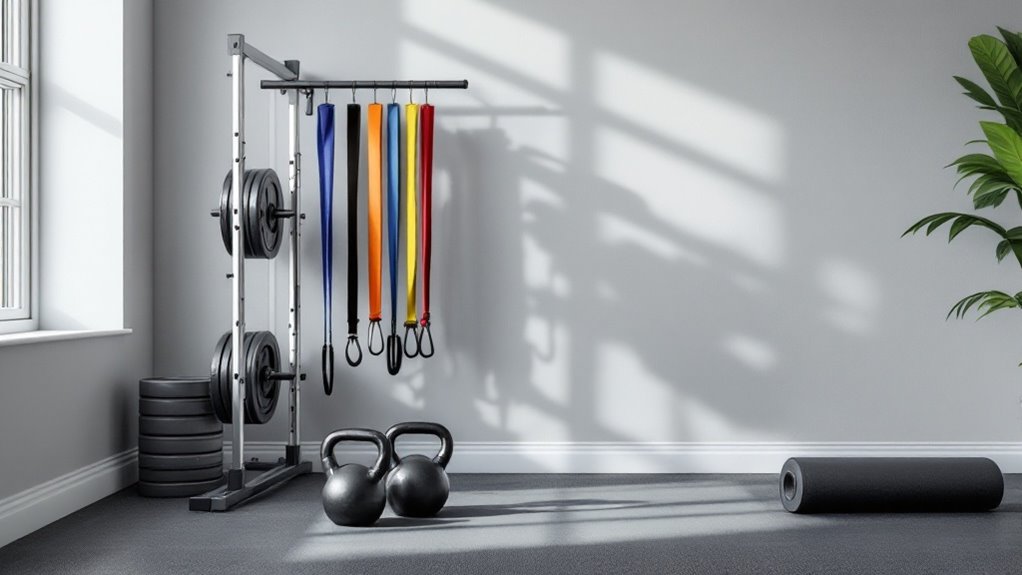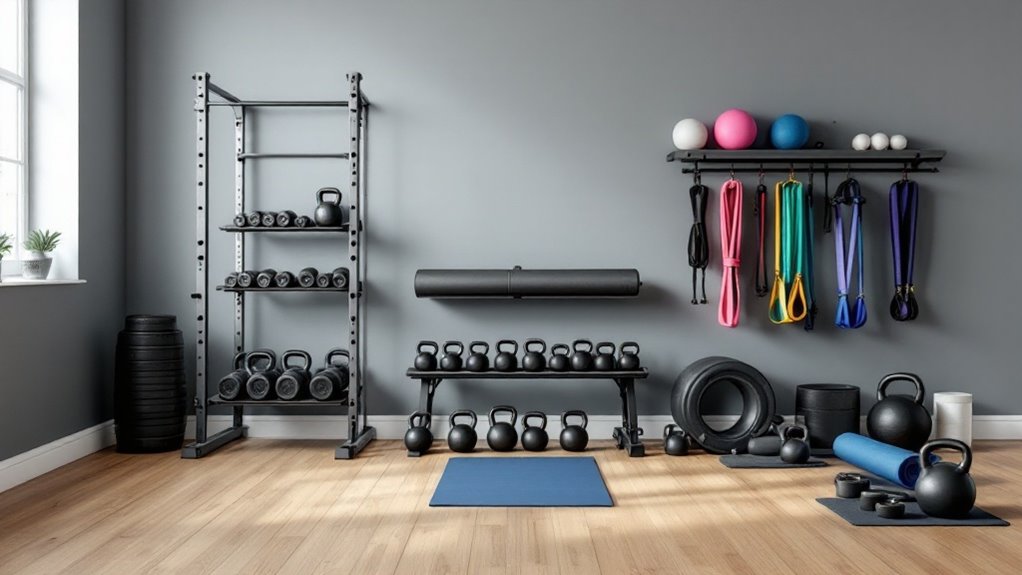Workout Programs for Weight Loss

An effective weight loss workout program combines targeted strength training 3-4 times weekly with strategic HIIT sessions to enhance calorie burn and preserve muscle mass. The ideal formula includes compound exercises like squats and deadlifts, complemented by high-intensity intervals such as burpees and sprints. A sustainable 500-calorie daily deficit, alongside proper nutrition timing and hydration, accelerates fat loss. This science-based approach reveals the full potential of body transformation.
Key Takeaways
- Combine 3-4 strength training sessions and 2-3 HIIT workouts weekly, focusing on compound exercises like squats and deadlifts.
- Perform high-intensity intervals such as burpees and sprints to maximize calorie burn and preserve muscle mass.
- Maintain a sustainable 500-calorie daily deficit while consuming 2.3-3.1g of protein per kilogram of body weight.
- Include circuit training and Tabata intervals to boost metabolism and increase post-workout calorie burn.
- Schedule 1-2 steady-state cardio sessions weekly alongside strength training for optimal fat loss results.
The Science Behind Effective Weight Loss Training

Understanding the science behind effective weight loss training requires exploring multiple physiological mechanisms that influence fat loss and body composition. The process centers on creating an energy deficit while preserving lean muscle mass through strategic exercise and nutrition protocols.
Creating a sustainable energy deficit through proper program design is essential for achieving long-term weight loss success. Low-carb diets combined with resistance training create ideal conditions for fat loss by suppressing insulin and maintaining metabolic rate. Engaging in strength training 3-5 days per week provides optimal frequency for sustained fat loss results.
HIIT workouts can significantly boost post-exercise calorie burn while preserving muscle mass.
The OPT™ Model's Phase 1 and 2 utilize high-rep ranges and short rest periods to increase metabolic demands, while proper nutrient timing improves fat utilization.
Research shows integrated programs that combine resistance training, cardio, and nutrition yield superior results compared to isolated approaches.
Building Your Perfect Weight Loss Workout Plan

Building an effective weight loss workout plan requires a strategic blend of exercise types, progressive intensity, and consistent tracking methods. The ideal program combines HIIT sessions for metabolic boost, strength training with compound movements, and moderate cardio for sustained fat loss. Maintaining a protein intake of 2.3-3.1 g/kg/day supports muscle preservation during weight loss phases. Compound exercises like squats and deadlifts maximize calorie burn while building functional strength.
Success hinges on implementing SMART goals with precise tracking mechanisms. A structured approach should include 2-3 HIIT workouts weekly, 3-4 strength sessions focusing on progressive overload, and 1-2 steady-state cardio sessions. Following a four-workout week structure with dedicated rest days optimizes recovery and results.
This framework, supported by proper nutrition timing and protein intake, creates the perfect environment for consistent weight loss while preserving lean muscle mass.
Essential Exercises That Maximize Fat Burning

Mastering fat-burning exercises requires a strategic selection of movements that deliver maximum caloric expenditure while engaging multiple muscle groups simultaneously. High-Intensity Interval Training (HIIT) stands at the forefront, with burpees and sprints leading the charge in calorie burning. Standing with movement can help burn more calories throughout the day compared to sitting still.
Mind-body practices can enhance weight loss by reducing stress and improving exercise recovery. For sustained fat loss, compound movements like kettlebell swings and rowing create a powerful one-two punch. These exercises not only torch calories during workouts but also boost metabolism long after. Floor sit-ups target the waist and upper abs while maintaining full back contact with the ground.
When structured in circuits or Tabata intervals, these movements become even more potent, transforming workouts into fat-melting powerhouses that build strength and endurance simultaneously.
Combining Nutrition and Exercise for Optimal Results

Successful fat loss demands a powerful alliance between strategic exercise and precise nutrition. Creating a sustainable 500-calorie daily deficit through combined diet and exercise enhances fat burning while preserving essential muscle mass.
This collaborative approach prevents metabolic slowdown and rebound weight gain. High-intensity interval training can significantly boost calorie burn during and after workouts. Strength exercises help increase metabolism by building lean muscle. Setting realistic weekly goals helps maintain motivation and consistency throughout your weight loss journey.
Proper nutrient timing increases workout effectiveness. Athletes should fuel with a balanced mix of carbohydrates and protein 1-3 hours pre-workout, then replenish with a 4:1 carb-to-protein ratio within the post-exercise window.
Maintaining consistent meal patterns, prioritizing whole foods, and staying hydrated optimizes fat oxidation and supports long-term weight management success.
Frequently Asked Questions
How Long Should I Rest Between Sets During Weight Loss Workouts?
Rest periods should vary based on exercise type and intensity.
For compound movements like squats and deadlifts, allow 1-2 minutes between sets to maintain proper form and strength.
For isolation exercises and circuit training, keep rest periods between 30-60 seconds to optimize calorie burn.
During HIIT portions, shorter rests of 20-30 seconds drive metabolic stress and fat loss while preserving muscle mass.
Can I Do Weight Loss Workouts While Recovering From Minor Injuries?
Like a ship traversing rough waters, exercising with minor injuries requires careful adaptation.
Working out during recovery is possible with proper modifications and professional guidance. Low-impact activities like swimming, cycling, or guided yoga can maintain weight loss progress while allowing healing.
It is crucial to obtain medical clearance, reduce intensity, and focus on uninjured body parts while following prescribed physical therapy routines.
Should I Work Out During My Menstrual Cycle for Weight Loss?
Working out during menstruation can greatly benefit weight loss goals.
Exercise releases endorphins that reduce cramps and boost mood while maintaining workout consistency.
Modify intensity based on menstrual phases – stick to low-impact activities during menstruation, increase intensity during ovulation, and adjust for fatigue in the luteal phase.
Regular exercise helps regulate sleep patterns and manages PMS symptoms effectively.
What's the Best Time of Day to Exercise for Maximum Fat Burn?
Like a bear hunting for salmon at dawn, the most effective time for fat burning is early morning, particularly between 7-9 AM.
Research shows morning workouts can increase fat oxidation by 20% due to lower glycogen levels and ideal hormonal conditions.
However, consistency matters more than timing – maintaining a regular exercise schedule, regardless of time, delivers the best long-term results for sustainable fat loss.
How Do Medications Affect Weight Loss Exercise Performance and Results?
Medications like GLP-1 agonists can markedly impact exercise performance through appetite suppression and potential dehydration.
Athletes may experience reduced energy levels and workout intensity initially. However, combining medications with structured exercise programs improves fat loss while preserving muscle mass.
High protein intake and proper hydration become vital for maintaining performance.
Post-medication success depends on establishing sustainable exercise habits and nutritional practices during treatment.
Final Thoughts
Persistent practice and proper planning pave the path to successful weight loss. By mindfully merging metabolic movements, muscle-building methods, and measured nutrition, individuals can create compelling changes in their composition. Committed cardio combined with strength training stimulates sustainable success, while sensible eating improves exercise effectiveness. Through this tactical training approach, transformation becomes tangible, turning fitness fantasies into fulfilled realities.


